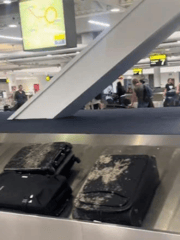It’s not too late to save using cash—but time is running out!
By
Maan
- Replies 0
Australians might soon face an inconvenient trade-off to keep cash alive.
What once felt like a win for bank customers could be the very thing threatening their ability to access physical money.
And the price of convenience might come back in the form of $2 ATM fees.
Australia's cash distribution system stood at a breaking point, with the country's sole remaining cash-in-transit provider, Armaguard, needing a $50 million annual subsidy to stay afloat.
The company, owned by the billionaire Fox family, controlled 90 per cent of the market yet remained unprofitable due to drastic shifts in how Australians handled money.
Back in 2017, the Big Four banks—Commonwealth Bank, Westpac, NAB and ANZ—scrapped the $2 fee for customers using rival ATMs.
At the time, the decision was welcomed by consumers, but finance experts now warned it set off a domino effect that pushed cash services to the edge.
Since that policy change, the number of ATMs in Australia dropped from 13,814 in June 2017 to just 5,476 by June last year, according to Australian Prudential Regulation Authority data.
Fewer ATMs meant fewer transactions, and that meant less revenue to sustain cash transport businesses like Armaguard.
In response, Armaguard last week secured a temporary $25.5 million bailout funded by the Big Four banks and retail giants including Woolworths and Wesfarmers, which owns Bunnings, Kmart and Officeworks.
‘Major banks and major retailers have reached an agreement with Armaguard to extend their financial contribution for a further six months,’ the Australian Banking Association confirmed.
Jason Bryce, founder of Cash Is Welcome, believed the original removal of ATM fees created the mess.
‘I think it was a bad, short-sighted move—I don't want to prescribe the answers—but the problems date from that decision,’ he said.
‘There's no doubt the $2 ATM fee for customers of other banks kept the cash distribution system paid for and viable in Australia—since 2017, since that decision, the cash industry has contracted and been under pressure.’
Bryce estimated the old ATM fees used to generate around $500 million in annual revenue—enough to make subsidies like Armaguard’s unnecessary.
‘There needs to be some kind of structural change to provide support, go forward, to cover the $50million-odd per year that Armaguard is now getting,’ he said.
‘There should be no need for $50million a year—the problem has been created by the banks and the supermarkets.’
He also noted the increasing reliance on third-party ATMs that charge higher fees, saying: ‘There's less bank-owned ATMs and there's more third-party ATMs that charge $3 or so.’
In 2023, Armaguard merged with its former rival Prosegur, but even as a united force, the company struggled.
‘The two big companies have merged into one and that one company is on the verge of bankruptcy,’ Bryce said.
Armaguard executive chairman Peter Fox blamed the company’s ‘shortfall in revenue’ on aggressive cost-cutting by the Big Four banks and major retailers.
Commonwealth Bank CEO Matt Comyn acknowledged the banks had been ‘very, very aggressive’ toward Armaguard.
‘The banks drove Armaguard to the brink of bankruptcy,’ Bryce added.
‘Matt Comyn says the banks underpaid Armaguard for cash-in-transit.’
‘It’s really up to the banks to pay more. So banks now don't really have much of a leg to stand on when they complain about handing over $25million for six months.’
To secure the future of cash, regulators floated the idea of appointing a dedicated federal minister for cash.
The Council of Financial Regulators—which includes the Reserve Bank of Australia—and the Australian Competition and Consumer Commission proposed that a registered entity oversee cash distribution services for key sectors of the market.
‘Despite the rise of digital payments, cash remains vital for many Australians, particularly in regional and remote communities,’ the consultation paper read.
‘Cash supports secure, inclusive, and resilient transactions for those who prefer or rely on it.’
A federal cash mandate was also scheduled to take effect from 1 January 2026, requiring businesses to provide customers with the option to pay using cash.
If you've ever felt frustrated trying to get cash or book an appointment at the bank, you're not imagining it.
The shift away from physical money is affecting more than just ATMs—it’s changing how banks interact with everyday customers.
For another look at how this trend is reshaping access to cash and service standards, here’s a related story worth reading.
Read more: Banks ditch cash as customer experience sparks concern

Will the return of ATM fees be the only way to save cash before it vanishes entirely?
What once felt like a win for bank customers could be the very thing threatening their ability to access physical money.
And the price of convenience might come back in the form of $2 ATM fees.
Australia's cash distribution system stood at a breaking point, with the country's sole remaining cash-in-transit provider, Armaguard, needing a $50 million annual subsidy to stay afloat.
The company, owned by the billionaire Fox family, controlled 90 per cent of the market yet remained unprofitable due to drastic shifts in how Australians handled money.
Back in 2017, the Big Four banks—Commonwealth Bank, Westpac, NAB and ANZ—scrapped the $2 fee for customers using rival ATMs.
At the time, the decision was welcomed by consumers, but finance experts now warned it set off a domino effect that pushed cash services to the edge.
Since that policy change, the number of ATMs in Australia dropped from 13,814 in June 2017 to just 5,476 by June last year, according to Australian Prudential Regulation Authority data.
Fewer ATMs meant fewer transactions, and that meant less revenue to sustain cash transport businesses like Armaguard.
In response, Armaguard last week secured a temporary $25.5 million bailout funded by the Big Four banks and retail giants including Woolworths and Wesfarmers, which owns Bunnings, Kmart and Officeworks.
‘Major banks and major retailers have reached an agreement with Armaguard to extend their financial contribution for a further six months,’ the Australian Banking Association confirmed.
Jason Bryce, founder of Cash Is Welcome, believed the original removal of ATM fees created the mess.
‘I think it was a bad, short-sighted move—I don't want to prescribe the answers—but the problems date from that decision,’ he said.
‘There's no doubt the $2 ATM fee for customers of other banks kept the cash distribution system paid for and viable in Australia—since 2017, since that decision, the cash industry has contracted and been under pressure.’
Bryce estimated the old ATM fees used to generate around $500 million in annual revenue—enough to make subsidies like Armaguard’s unnecessary.
‘There needs to be some kind of structural change to provide support, go forward, to cover the $50million-odd per year that Armaguard is now getting,’ he said.
‘There should be no need for $50million a year—the problem has been created by the banks and the supermarkets.’
He also noted the increasing reliance on third-party ATMs that charge higher fees, saying: ‘There's less bank-owned ATMs and there's more third-party ATMs that charge $3 or so.’
In 2023, Armaguard merged with its former rival Prosegur, but even as a united force, the company struggled.
‘The two big companies have merged into one and that one company is on the verge of bankruptcy,’ Bryce said.
Armaguard executive chairman Peter Fox blamed the company’s ‘shortfall in revenue’ on aggressive cost-cutting by the Big Four banks and major retailers.
Commonwealth Bank CEO Matt Comyn acknowledged the banks had been ‘very, very aggressive’ toward Armaguard.
‘The banks drove Armaguard to the brink of bankruptcy,’ Bryce added.
‘Matt Comyn says the banks underpaid Armaguard for cash-in-transit.’
‘It’s really up to the banks to pay more. So banks now don't really have much of a leg to stand on when they complain about handing over $25million for six months.’
To secure the future of cash, regulators floated the idea of appointing a dedicated federal minister for cash.
The Council of Financial Regulators—which includes the Reserve Bank of Australia—and the Australian Competition and Consumer Commission proposed that a registered entity oversee cash distribution services for key sectors of the market.
‘Despite the rise of digital payments, cash remains vital for many Australians, particularly in regional and remote communities,’ the consultation paper read.
‘Cash supports secure, inclusive, and resilient transactions for those who prefer or rely on it.’
A federal cash mandate was also scheduled to take effect from 1 January 2026, requiring businesses to provide customers with the option to pay using cash.
If you've ever felt frustrated trying to get cash or book an appointment at the bank, you're not imagining it.
The shift away from physical money is affecting more than just ATMs—it’s changing how banks interact with everyday customers.
For another look at how this trend is reshaping access to cash and service standards, here’s a related story worth reading.
Read more: Banks ditch cash as customer experience sparks concern
Key Takeaways
- The number of ATMs in Australia has more than halved since 2017.
- Armaguard requires $50 million a year to continue operating.
- Experts say scrapped ATM fees triggered the decline of the cash system.
- A new federal minister for cash may be appointed to oversee distribution.
Will the return of ATM fees be the only way to save cash before it vanishes entirely?








